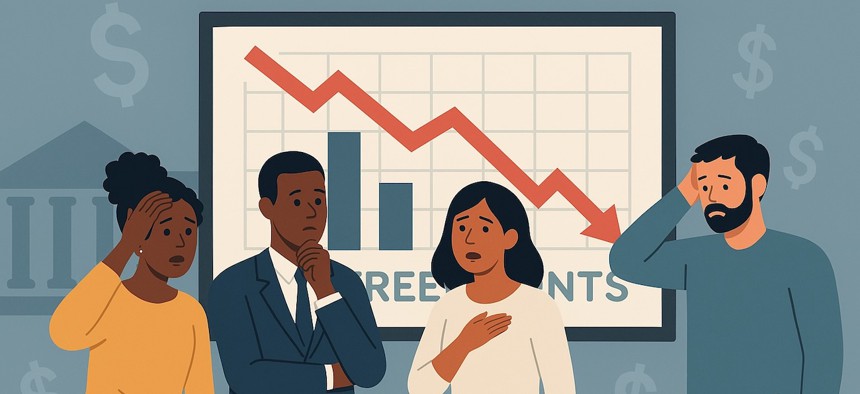
Illustration by OpenAI
Why federal retirements are spiking this year
A sharp rise in retirement claims may be tied to fear instead of planning. If you're eyeing the exit, make sure you're not rushing into something you'll regret.
The Office of Personnel Management received 70,351 retirement applications by the end of June—nearly a 40% increase over the same period in 2024, when 50,305 applications were filed.
The uptick is not unexpected. Federal workforce reductions have been underway since the “Fork in the Road” memo was issued in late January. That program, now closed, introduced a Deferred Resignation option that allowed employees to stay on the payroll without performing duties, with the expectation they’d resign or retire by Sept. 30, 2025.
But many employees didn’t wait.
A spike in May and June retirements appears to be driven by concerns over changes to retirement benefits that were initially outlined in the “Big Beautiful Bill,” signed into law July 4.
In the end, none of the proposed cuts to federal retirement benefits made it into the final version of the bill.
The high-three salary calculation remains in place. FERS employees who retire before age 62 with an immediate, unreduced annuity will continue to receive the Special Retirement Supplement, bridging the gap to Social Security eligibility at age 62.
Still, many employees rushed into retirement without fully preparing for the long-term financial impact. If you’re one of them—or are considering retirement—here are some critical questions to ask yourself:
-
Are your savings enough to supplement your FERS and Social Security benefits?
-
If married, do you understand the cost and value of the survivor benefit election?
-
Do you know your options for continuing FEGLI coverage?
-
Have you accounted for potential long-term care costs?
-
Did you save enough in the Thrift Savings Plan?
A Closer Look at the Numbers
Let’s say you earned $105,000 annually, with take-home pay of $73,500 after withholdings.
If you retire under FERS with 30 years of service, your benefit would be about 30% of your high-three salary, or $30,000. Add the Special Retirement Supplement—roughly $15,000—and your gross benefit would be $45,000 annually.
If you elect the full survivor benefit, your FERS annuity would be reduced by 10%, lowering your total to $42,000.
After taxes and insurance, that could drop to around $32,000—$41,500 less than your pre-retirement net income, or about $3,400 less per month.
Even with a $1 million TSP balance, you’d need to plan carefully to close that gap—especially after taxes.
Key Questions to Consider
-
How much will you need to withdraw from your TSP each year?
-
Will you need to cut spending to make ends meet?
-
Do you need to match your net income in retirement—or just get close?
-
Will your benefits keep up with inflation?
Longevity Is a Risk—But One You Can Prepare For
A lack of "longevity literacy" is hurting retirement planning, according to a 2023 survey by the TIAA Institute and the Global Financial Literacy Excellence Center at George Washington University.
Fewer than 40% of adults correctly estimated average lifespan at age 65. One in four people who are 65 today will live past 90. One in 10 will live beyond 95, according to the Social Security Administration.
Only 12% of respondents demonstrated strong longevity literacy by correctly answering related questions.
Spending may actually increase in early retirement, as retirees pursue long-postponed travel, hobbies, or family goals like helping kids with weddings or college.
Survivor Benefits and Life Insurance
Have you considered:
-
How much income your spouse will need if you pass away first?
-
Whether life insurance can replace the survivor benefit?
-
How long you and your spouse might live—and how inflation could affect your finances?
Basic FEGLI coverage continues at no premium after age 65, though it gradually reduces. Optional coverage is available but comes with rising premiums. You’ll elect FEGLI continuation using form SF 2818.
Planning for Long-Term Care
Long-term care is one of the biggest threats to retirement security.
Medicare doesn’t cover it, and Medicaid eligibility requires meeting strict income and asset thresholds—often as low as $2,000 in assets for individuals.
According to Morningstar, baby boomers can expect to spend an average of $250,000 on long-term care in retirement.
Don’t Count on an Inheritance
Many people assume they’ll inherit enough to cover gaps in retirement funding. But medical bills, divorce or longevity may drain your parents’ assets.
A better plan is to save independently—then any inheritance is a bonus, not a necessity.
Retirement Myths That Can Hurt You
-
“I have time to save later.” You lose out on compound interest by waiting. Start now, even with a small amount.
-
“I won’t live that long.” Average lifespans have risen, and 25% of people 65 today will live past 90.
-
“My kids’ college comes first.” There are loans for school, but not for retirement. Make both priorities if you can.
-
“I’ll work in retirement.” Many who plan to work can’t, due to age discrimination or health issues.
-
“I’ll need less money in retirement.” That might not be true, especially in the early years when you’re more active.
Bottom Line
You can’t change the past, but you can start making better financial decisions today.
Don’t let misconceptions—or wishful thinking—undermine your future. A thoughtful retirement plan can help ensure your post-federal life is secure, fulfilling, and free from financial regret.







